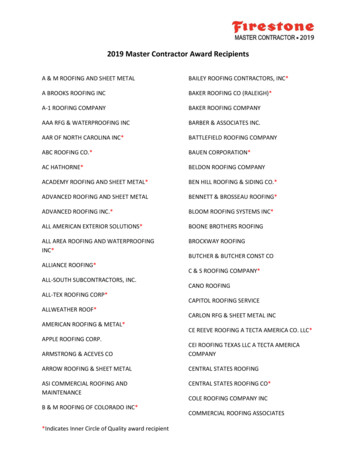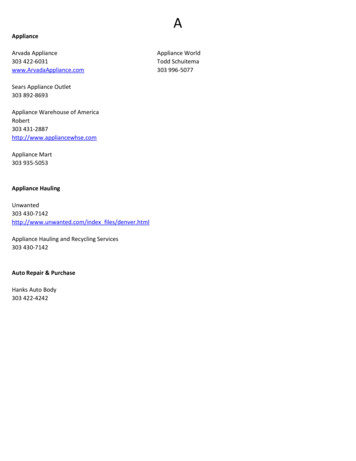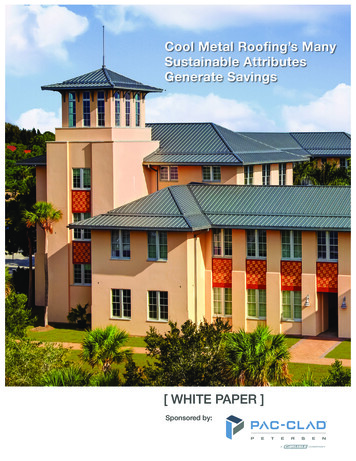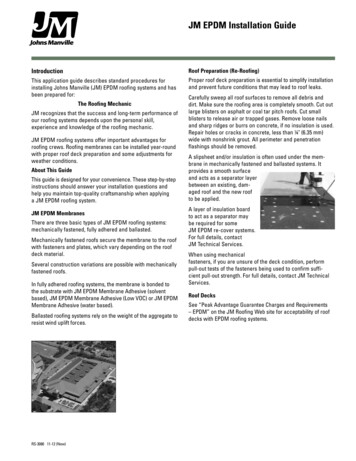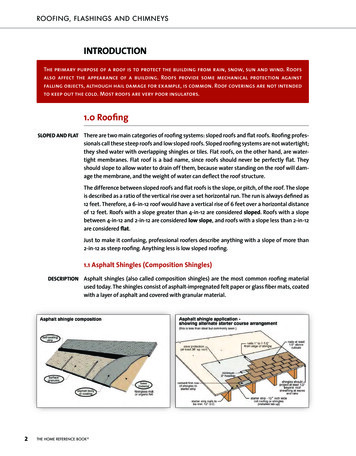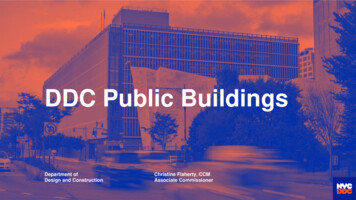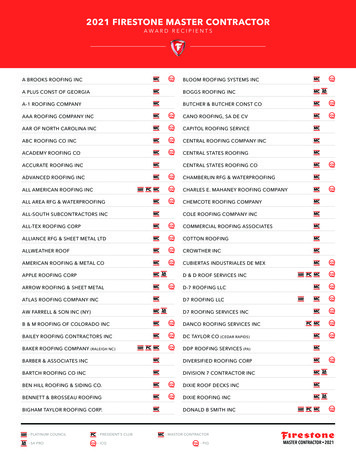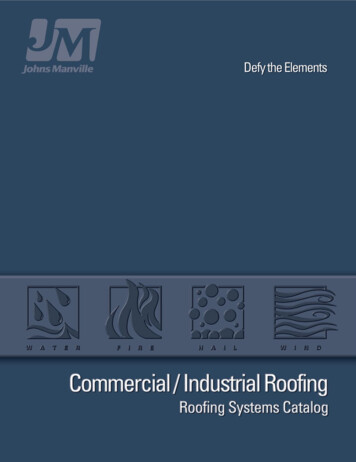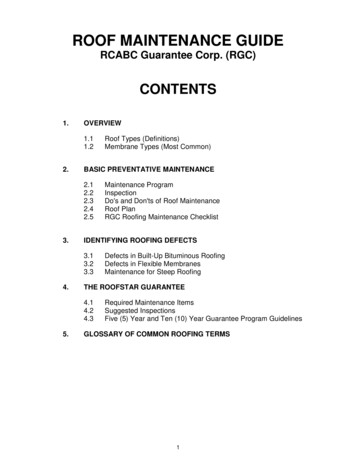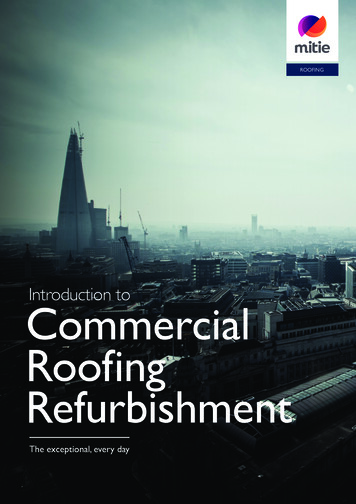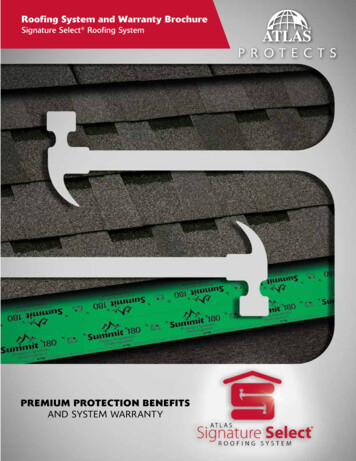
Transcription
DDCCOOL & GREENROOFING MANUALPrepared forNYC Department of Design & ConstructionOffice of Sustainable Design byGruzen Samton Architects LLP withAmis Inc.Flack Kurtz Inc.Mathews Nielsen Landscape Architects P.C.SHADE Consulting, LLCJune 2005/June 2007
This document is an introduction to environmental roofstrategies, both reflective and planted roofs. Its basic goalis to evaluate the effectiveness of these strategies for NewYork City projects. The guidelines are addressed to all theparticipants in projects for the NYC Department of Designand Construction (DDC) – administrators and managersfrom DDC, architects and their consultants, andconstruction managers.EXECUTIVE ACKNOWLEDGEMENTSHonorableMichael R. BloombergMayor, City of New YorkDavid Burney, AIACommissioner, NYC Department of Design and ConstructionDDC Architecture and Engineering Division:Margot A. Woolley, AIA, Assistant CommissionerJohn Krieble, RA, Director, Office of Sustainable DesignKerry Carnahan, Office of Sustainable Design
table of contents121.1ddc prefaceoverviewEnvironmental Impacts of Hot, Dark RoofsWhat is to be Done?Considering Cool SolutionsWhat’s Happening In New YorkRelevance to NYC Department of Design & Construction3energy evaluation4cool roof considerations5green roof considerations6implementation resourcesThe Energy ModelEnergy SavingsCost AnalysisCool Roof StandardsGoing From Hot to CoolReflectance and Emittance ExamplesCool Roof CoatingsMaintenanceGreen Roofs and DDC’s Sustianability BudgetGreen Roofs in Environmental TermsBenefits in Human TermsGreen Roof Technical ConsiderationsDesign ConsiderationsImplementation ConsiderationsMaintenence ConsiderationsInternet ResourcesReducing New York City’s urban heat island effect - DDC .35.55.85.115.136.16.5ddc cool & green roofing manual table of contents
1DDC PREFACE
preface nyc department of design and constructionIn recent years, there has been great interest in the potential of two roofing strategies – “cool” (or lightcolored) roofs and “green” (or planted) roofs – to reduce the energy consumed by individual buildings,as well as mitigate large-scale urban environmental problems like the Urban Heat Island Effect andcombined sewer overf low events. This is particularly true in urban areas where roofs constitute a largepercentage of the overall surface area. In New York City, for example, roofs constitute 11.5% of the totalarea, or roughly 944.3 billion square feet.The New York City Department of Design and Construction, as the construction arm of the New YorkCity government, is responsible for many of those roofs, and manages an annual budget of approximately 500 million dollars for building construction and renovation. Additionally, DDC is responsible forguiding City projects toward better, greener buildings within limited construction budgets. Accordingly,the cool and green roof strategies in this report are discussed primarily in terms of their environmentaleffectiveness – would this be the best way to allocate “green strategy” project money for the most environmental benefits?This manual attempts to provide DDC’s managers and consultants with theoretical, historical, and technical information on different roofing strategies so they can make well-informed decisions on a projectbasis. In order to more accurately discuss the thermal behavior of cool and green roofs, we hired Flackand Kurtz, Inc. and SHADE Consulting, LLC to perform energy simulations of a range of different roofson a hypothetical DDC building in NYC; the results included in this manual indicate that, when considered at the scale of a single building, both cool and green roofs have a very modest impact on buildingenergy consumption. However, when considered as a strategy to help reduce the Urban Heat Island Effect, the reduction in energy use is more dramatic and therefore supports the claim that the added costfor a cool roof, though not for a green roof, is justified in terms of energy savings. This conclusion issupported by a report entitled “Mitigating New York City’s Heat Island with Urban Forestry”, recentlypublished by the New York State Energy Research and Development Authority (NYSERDA), and by theDDC analysis included as an Appendix to this report.The research provided here by Gruzen Samton Architects, LLP also indicates that, in addition to greenroofs not being very cost-effective as a way to save energy, there is currently insufficient data availablespecific to NYC on the relative cost and feasibility of including green roofs in the city’s plans for stormwater and air quality management. Though certainly the question of whether green roofs have a role to playfor NYC in these other areas warrants further study, it is already clear that various types of green roofsoften appeal to building occupants and the surrounding neighborhood when conceived and designed asamenities that enhance the livability of the city. Examples of such amenities might include accessibleroof gardens, views of planted roofs from adjacent taller buildings, and even habitat for wildlife, with themost appropriate application and design being determined by program, budget, and the physical contextof a particular project.Office of Sustainable DesignNYC Department of Design and ConstructionJune 2007ddc cool & green roofing manual ddc preface1.1
2OVERVIEW
overviewNew York City has almost one billion square feet of roof area, and people are starting to pay attention to it.Increasingly, cool and green roofing strategies are proposed as solutions to a number of endemic urbanproblems, ranging from high energy bills to the Urban Heat Island Effect to excess stormwater runoff.Although research and monitoring is underway in the Northeast, the quantitative results have not caughtup with the claims for cost-effectiveness and performance in energy savings and stormwater reduction.To date, most of the research and evaluation has been done in climates warmer than New York City, and/or with buildings that have not had to conform to energy codes and other requirements equivalent to thatof New York State. This manual looks at the research to date and the potential for cool and green roofs,from the point of view of NYC’s Department of Design and Construction and their project profile.Our intention here is to offer some insight into the many issues related to the use of cool and greenroofs in New York City, while also providing DDC project managers and consultants with a basic manualon their implementation. In this manual, we discuss in-depth a number of cool and green strategies,consider the practicality of using them on DDC’s construction projects, and evaluate whether theyimprove the local environmental performance of a typical DDC building. Energy modeling projectedindividual building energy cost savings, using project types and utility rates applicable to City projects.The cumulative environmental impact of citywide cool and green roofing is considered in context withother potential strategies to cool off the city.Our findings on energy savings, as demonstrated by the energy evaluation presented in the next chapter,show that neither cool roofs nor green roofs are particularly cost effective strategies for energy-usereduction in new or existing buildings in New York City. However, when combined with other UrbanHeat Island mitigation strategies, the case for cool roofs– particularly on existing buildings– becomesfar more compelling.environmental impacts of hot, dark roofsOn a hot, sunny summer day, the temperature of a black roof surface can be about 90 F above theambient air temperature (ie, 180 on a 90 day). This is because non-ref lective roofs absorb and retainsolar energy as heat, which contributes not only to a hotter roof, but also to uneven thermal expansion/contraction and aging of the roof, and sometimes to heat gain within the rest of the building. The topf loors of the building underneath can be heated up by the hot roof, and cause either discomfort for thebuilding inhabitants or increased local cooling loads–particularly in older buildings, which tend to haveless insulation. Because of the heat stored in non-ref lective roofs, both the city and individual buildingsstay hotter and begin the summer day at a temperature much higher than that of the suburbs.It’s not just your imagination: the city really is warmer than the surrounding countryside. In the summer,average temperatures in the largest cities can range from 5 to 10 warmer. This phenomenon, known asthe Urban Heat Island Effect, results from several factors in addition to dark roofs–chief ly the relativedearth of vegetation in cities and the preponderance of dark surfaces on roads and parking areas. All ofthese factors work together to compound the problem: dark surfaces absorb heat, and a lack of vegetationdeprives us of the natural cooling that living plants provide.In cities, there are vast areas of dark asphalt roofs and roadways absorbing heat and amplifying heat gainon the macro-scale, which can affect the very climate of cities and metropolitan areas. Not only do citiesas a whole become hotter, the wind patterns can change, and there is evidence that cities can attract oreven cause thunderstorms.1Increased temperatures in cities have been recorded for almost 200 years. In 1807, Luke Howard, anamateur meteorologist, began comparing the temperatures of various sites in London with those several1.See: 1500sci-environ-climate.htmlddc cool & green roofing manual overview2.1
miles outside the city. In 1818, he published a book, The Climate of London, which concluded that Londonis “always warmer than the country, the average excess of its temperature being 1.579 degrees.” As citieshave grown in density and scale, this temperature differential has undergone a marked increase.Besides making us uncomfortable, the added heat damages the environment in the following ways: Hotter roofs and higher air temperatures mean hotter buildings and/or more energy consumed byair conditioning. In addition, the heat rejected by air conditioning adds further to the heat generatedin the city. Increased consumption caused by the Urban Heat Island Effect occurs during peaks of energyconsumption. This is a real problem in New York City, where a shortage of peak capacity may resultin more frequent blackouts. A hotter city means more air pollution. Not only does increased heat cause more energy consumptionbecause of cooling loads, but the energy production adds pollutants such as nitrous oxides, sulphurdioxide and carbon dioxide to the air. On the peak summer days, it also taxes the utility companies,pulling online the older, less efficient power plants. Resulting emissions of greenhouse gasescontribute to local air pollution and global warming. Pollution increases with the ambient outdoor temperature. Ground level ozone (smog), a healthhazard, is produced when pollutants such as nitrous oxide and volatile organic compounds combinephotochemically in the presence of sunlight and heat. This occurs much more readily at the highertemperatures. Urban heat can even cause deaths. A 1995 heat-wave in Chicago is estimated to have killed over700 people– over twice as many as perished in the infamous Chicago Fire of 1871. Many of thosewho died were low-income persons who did not have air-conditioners and were unable to protectthemselves from the ambient temperatures. Even more shocking was the European heat wave ofAugust 2003, which is estimated to have claimed the lives of 35,000 people, with over 14,000 dyingin France alone.impacts on nyc–considering global climate changeNew York City is undeniablyexperiencing a gradualincrease in temperature,thanks not only to theUrban Heat Island Effectbut also to global climatechange caused by a centuryand a half of increasinggreenhouse gas emissionsfrom industrialized nations.According to a 2001 study bythe Columbia Earth Institutefor the U.S. Global ChangeResearch Program, ClimateThermal Imaging of NYCCox, J., M. Chopping, S. Hodges,L. Parshall, C. Rosenzweig, andW.D. Solecki. 2004. Urban HeatIsland and the Built Environment:Case Study of New York City. Association of American Geographers.March, 2004. Philadelphia, PA.2.2overview ddc cool & green roofing manual
Change and a Global City, there has been an increaseof approximately 2 F in the New York region since1900. Regional rature rise is predicted to accelerateover the 21st century, with warming projected torange from 1.7 F to 3.5 F in the 2020s.roofs and ddcCool roofs are required on DDC projects.DDC’s Consultant Guide requires low sloperoofs to have a ref lectance of 0.65, andDDC recommends meeting the emittancerequirements of California Title 24 or LEED.A few degrees may seem insignificant. However,if this trend is not arrested, the consequences aregrim and far-reaching. The effects of global climatechange will be most painfully felt in the planet’sNYC’s New Construction Codes requiretropical climates and coastal communities. NYCwhite or Energy Star roofing on low-slopelies in a temperate climate zone; however, withroofs. (effective July 2008)hundreds of miles of shoreline and a projected 9.1million inhabitants by 2030, it is certainly one of theGreen roofs are permitted by the Newworld’s largest coastal communities, and thereforeConstruction Code, and PLANYC 2030vulnerable. Sea levels along the New York coastproposes to encourage them with a taxcould rise as much as 5 inches by the 2030s, makingincentive. DDC considers green roofs on af looding and inundation of all low-lying areas ofproject-by-project basis – see text.NYC–in particular lower Manhattan, SouthernBrooklyn and Queens, and Staten Island–morelikely during major storm events, causing damageto property as well as transportation and other vitalurban infrastructure. The city’s water supply would suffer in terms of both quality and quantity, and thetotal energy demand would rise in order to meet intensified summer cooling. Additionally, the numberof summer days above 90 F could rise from 14 days in 1997-1998 to between 40-89 days by the 2080s,increasing the number of heat-related deaths, expanding habitat and population of disease-carryinginsects and exacerbating asthma-inducing pollution.1what is to be done?So what can DDC and its consultant teams do? Becausebuildings and paved surfaces are the major contributorsto the Urban Heat Island Effect, each project has anincremental effect on the temperature and livabilityof the City. We can replace dark surfaces with lighter,more ref lective, ones and reintroduce vegetation wherepossible, and of course construct more energy efficientbuildings. As with many more sustainable approaches,the simplest and most obvious solutions can be informed by the intuitive principles and practices of ageold communities and dwellings.photo: Ruben TomasovThe threat of climate change demands an immediate, global reduction of greenhouse gas emissions,requiring action at every governmental level, from national to municipal. New York City has taken upthe challenge with a comprehensive sustainability plan, PlaNYC 2030 (page 2.5). Like every successfulcampaign, it is made up of incremental, doable actions.Cool Surfaces. We know that lighter colors keep us cool, since they ref lect heat, while darker colors tendto keep us warmer, and so we wear lighter colored clothes in the summer than in the winter. Traditionalcultures have exploited this phenomenon – think of the white-washed villages of the Greek islands,where every part of the village, from the walls, to the roofs, to the streets, are painted uniformly white toref lect the scorching rays of the summer sun.1.PlaNYC, A Greener, Greater New York; 2007ddc cool & green roofing manual overview2.3
In more scientific terms, we can discuss the cool, bright, white surfaces of Mediterranean villages in termsof two important and related surface properties: solar ref lectance and thermal emittance. Ref lectance,also known as albedo, is a percentage scale expressing the ability of a surface to ref lect the sun’s rays,rather than absorb the solar energy as heat. The ability of the material to then radiate away any energyabsorbed as heat back into the atmosphere, or cool off, can be expressed by emittance, also a percentagescale. If we begin to use materials and surfaces with high ref lectance and emissivity, we can ref lectand radiate away some of the trapped solar energy that is heating our city. On the same hot 90 F degreeday previously mentioned, a bright white smooth roof will only be about 15 above the air temperature,rather than 90 F. The Heat Island Group at Lawrence Berkeley Laboratories, lead by Hashem Akbari, hasdone studies indicating that if dark roofs were replaced by highly ref lective roofs, throughout an entiremetropolitan area, the urban heat island effect could be reduced by 2-3 F.Planting. Also, we have all experienced how much cooler it is in a grove of trees than in a parkinglot, and how much hotter it is to walk barefoot on asphalt pavement than on a lawn. Plants providenatural cooling in several ways – by providing shade, by utilizing the sun’s energy in photosynthesis,and, most importantly, by evapotranspiration, which is similar to perspiration. When plants transpire,they turn water into vapor, dissipating the latent heat of vaporization and providing cooling. This processcan dissipate a lot of heat; A mature tree provides approximately three tons of free cooling throughtranspiration. Green roofs offer an opportunity to introduce vegetation to a large number of expansivesurfaces, many of which would otherwise be dark, heat absorbing and unused. The Organization forLandscape and Urban Greenery Technology Development estimates that if half the roofs in Tokyo wereplanted with gardens, the hottest summer temperatures would fall by 1.5 F.table 1: roof temperature rise above air temperature – full sun/no windmaterialtemperature riseBright white smooth 15º FRough white surface 35º FMedium grey 52º FBuilt-up Roofing with Gravel 61-83º FBlack Material 90º FSource: LBNL Cool Roofing Materials DatabaseSo What About the Winter? In New York it might seem that the disadvantages of a cool roof in winterwould offset the advantages in the summer. This has been found to be the case in very cold climates, suchas Minneapolis, and climates in which the summers are cloudy and cool, such as Seattle. In New YorkCity, there is a winter penalty, but the benefits in summer outweigh it. Lawrence Berkeley Laboratory’sHeat Island Group conducted a study in 1997 that examined the energy conservation effect of changingto white roofs in 11 US Cities.2 Lawrence Berkeley National Laboratory (LBNL) used computer modelingthat considered factors including cooling degree days, sunny/cloudy days, lost heat gain in winter, typicalroof color currently, local electricity costs, etc. While it showed much greater savings in sunbelt citieslike LA and Phoenix, the study projected cost savings for NYC with cool roof systems. Specific to thewinter penalty, LBNL estimated that the solar absorption effect is less in December than June, becausethe days are shorter, the sun is lower in the sky and the winter is much cloudier. Also, the energy costs ofair conditioning (mostly electric, and at times of peak demand) and heating (mostly gas or oil) factoredinto the analysis. In addition to energy conservation, the other summer impacts of pollution and ozoneproduction are greatly reduced in the winter.considering cool solutionsOur analysis of the possible solutions cool and green roofs might offer was on the building-specificimpact. In order to determine how much energy they would save per building in New York City’s climate,2.4overview ddc cool & green roofing manual
we ran an energy model of a new, typical-for-DDC building, varying the ref lective and emissive propertiesof the roof to determine the annual energy savings.Cool Roofs. We found that for new city government buildings, none of the cool roofs analyzed wouldpay for themselves in energy savings within the lifespan of the roof, given the government’s relatively lowenergy rates, and assuming a well-insulated, and efficient building. (One exception is a metal roof, forwhich there is typically no upcharge for a light color.) For older, less efficient private structures payingConEd rates, simple paybacks for cool roofs are between five to fifteen years for individual buildings – amore justifiable expenditure. The cost-effectiveness of cool roofs becomes truly compelling when thesavings on individual buildings are added to savings generated by the ability of many cool roofs to lowerthe overall temperature of the whole city (See below: cumulative impacts). In addition, cool roofs canextend the life of the roof membrane by decreasing thermal cycling and protecting them from ultraviolet radiation. For these reasons, DDC is requiring cool roofs on all new projects and on all re-roofingprojects (see page 2.8).Cumulative Impacts. It has been shown that introducing lighter, morephoto: Mathews Nielsen Landscape Architects P.C.Green Roofs. We also found that, per unit area, green roofs save overtwice the energy as cool roofs, but since their cost is more than an orderof magnitude higher, their paybacks are extremely long. For a new citygovernment building paying low rates, the simple energy payback periodis in the hundreds of years, and even for older private buildings payinghigher rates, the simple payback period is still in the range of 70 years. Ifimplemented on a large scale, green roofs, like cool roofs, can contributeto an overall reduction in the city’s temperature, but their combinedeffect on individual buildings and citywide savings is not sufficientlycost-effective to recommend them for general City project use as anenergy-efficiency measure.Tribeca Green, Manhattanref lective surfaces and/or more greenery can mitigate heat build-up on the scale of individual buildings.But how cost-effective would it be to reduce the ambient air temperature and cooling load of the City ofNew York by lightening or greening the city on a large scale?Each more ref lective and greener building contributes to the City’s overall ability to mitigate NYC’sUrban Heat Island Effect. The New York State Energy Research Development Authority (NYSERDA),recently published a study, Mitigating New York City’s Heat Island with Urban Forestry, Living Roofs,and Light Surfaces. The study used a regional climate model to analyze the cost effectiveness of variousstrategies for reducing the City’s air temperature. They found that a combined strategy of vegetation,especially street trees, and lighter surfaces on roof and pavements is most effective overall. Light surfaces,light roofs and street trees were found to be the most cost-effective strategies per degree of temperaturereduction.what’s happening in new yorkPlaNYC 2030. New York City set forth a comprehensive sustainability plan in 2007. Called PlaNYC2030, it aims to reduce the City’s greenhouse gas footprint, committing to reducing citywide carbonemissions by 30% below 2005 levels by the year 2030 with a series of initiatives, such as reduced Cityenergy consumption and use of cleaner energy. The plan addresses change and proposes steps in sixcategories, land, water, transportation, energy, air and climate change.PlaNYC’s greenhouse gas reduction goal was conceived with vision on a global scale, and implementationon a smaller scale, with specific initiatives that create an integrated strategy. Addressing the Heat IslandEffect with lighter surfaces on roofs and paving, and the introduction of more overall planting are amongthe implementation plans. White or ref lective roofs will be required in the New Construction Codes totake effect in July 2008.ddc cool & green roofing manual overview2.5
PlaNYC encourages the installationof green roofs as a measure tocontrol stormwater runoff andavoid Combined Sewer Overf lows(CSO). The proposed incentive isa property tax abatement to offset35% of the installation cost of thegreen roof.New York Ecological Infrastructure StudyImaging used as an analysis tool in a study exploring the potential ofvegetated roofs to address environmental issues.DDC has already incorporated coolroofs on a number of projects whichmeet the emittance and ref lectancecriteria of LEED. Among themare the Office of EmergencyManagement, New DOT SunriseYard, Glen Oaks Branch Library,and Department of HomelessServices. In addition, DDC has twocurrent projects that incorporategreen roofs – the Queens BotanicalGarden and the Kingsbridge BranchLibrary in the Bronx.Cox, J., M. Chopping, S. Hodges, L. Parshall, C. Rosenzweig, and W.D. Solecki.2004. Urban Heat Island and the Built Environment: Case Study of New YorkRegional research on the UrbanCity. Association of American Geographers. March, 2004. Philadelphia, PA.Heat Island Effect and ways tomitigate it have been going on for several years. A recently published study, Mitigating New York City’sHeat Island with Urban Forestry, Living Roofs, and Light Surfaces, is mentioned above. In addition to thatstudy, the Earth Institute at Columbia University and NASA/Goddard Institute for Space Studies havepartnered with other researchers for several projects. Among them are New York Ecological InfrastructureStudy Green Roof Project (with Hunter College-CUNY, Earth Pledge and Pennsylvania State University’sCenter for Green Roof Research) and Climate Change and a Global City (with numerous stakeholderinvolvement).Green, planted roofs are gradually appearing in New York City, sponsored by community groups,environmental organizations, institutions and private developers. Recent installations include SilvercupStudios in Long Island City, with a 35,000 square foot extensive roof, with funding assistance from theQueens Clean Air Project. Also in Long Island city is the Gratz Industries Building, with a green roofcovering about three quarters of its 11,000 square foot rooftop, allowing comparative research to the nonplanted portion. In the Bronx, the County Courthouse has a 10,000 square foot extensive green roof.This is the first to be managed by the NYC Department of Citywide Administration (DCAS).Sustainable South Bronx, a community based organization to address environmental needs and policiesof the South Bronx, is an advocate for green and cool roofs in New York City. They have partnered withColumbia University’s Cool Cities Project, sponsored workshops and promoted green roofs on a citywide scale.Earth Pledge, a not-for-profit organization dedicated to sustainability, has established the Green RoofsInitiative to promote and support the development of green, vegetated rooftops in New York City. Theyestablished a Green Roof Policy Task Force to bring together city, state and federal agencies to explore thepublic policy issues of developing green roofs in the City. Earth Pledge has launched Greening Gotham,whose mission is to transform NYC’s rooftops into a living network of meadows and gardens, by providingexamples and a toolbox of implementation information. Earth Pledge is monitoring environmental2.6overview ddc cool & green roofing manual
effects such as temperature and stormwater retention for the green roofs at Silvercup Studios and GratzIndustries, mentioned above.The Battery Park City Authority has issued green guidelines and prescriptive requirements for newconstruction in Battery Park City. For roofing on new construction, a green planted roof must be installedfor 75% of the open roof area, and all other roofing must have a minimum ref lectance value of 0.30. Atthis time, Battery Park City has the NYC’s most concentrated grouping of buildings with planted roofs.what other states and cities are doingThe State of California has established Title 24 standards (California Code of Regulations, Title 24,Part 6 Energy Efficiency Standards for Residential and Non-Residential Buildings) for residences andcommercial buildings. Using cool roofs is an important energy efficiency compliance strategy, one ofseveral methods of fulfilling the standards. Title 24 cites minimum ref lectance and thermal emittancefor different types of roofing materials. Title 24 standards are of note because they are well known andoften referenced by roofing manufacturers.Other cities and states are focusing on the integration of cool and/or green roofs into their building policies.There are many examples. The Georgia White Roof Amendment requires the use of additional insulationfor roofing systems whose surfaces do not have test values of 75 percent or more for both solar ref lectanceand emissivity. A number of cities–e.g. Milwaukee,Pittsburgh, Portland, Seattle–have incorporated greenroofs into their policies for stormwater control.relevance to nyc departmentof design & constructionSoon we will be seeing more cool roofs in New York City–both because of increased environmental awareness andbecause they will be required.photo: 2004 Roofscapes, Inc.; used bypermission; all rights reservedThe City of Chicago, Illinois has been successful in policy making for both planted and cool roofs, andwas one of the first US cities to encourage planted roofs, including the roof of City Hall, and monitortheir effects. Cool roof are required. For now low-sloped roofs have a minimum weathered ref lectanceof 25 percent, however, after December 31, 2008, all low-sloped roofs must meet or exceed Energy Starcriteria. Green roofs qualify for this requirement. Chicago is working with the US EPA and DOE toassess the impacts of these roofs on Chicago’s heat island.Chicago City HallDDC’s Design Consultant Guide - 2003 requiresthat roofs have a minimum ref lectivity of 0.65, based on the EPA/DOE’s Energy Star standard forlow-slope roofs (most of DDC’s projects have low-slope roofs). Emittance was not specified in the Gu
percentage of the overall surface area. In New York City, for example, roofs constitute 11.5% of the total area, or roughly 944.3 billion square feet. The New York City Department of Design and Construction, as the construction arm of the New York City government, is responsible for many of those roofs, and manages an annual budget of approximate-
